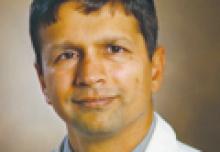HILTON HEAD—Many neurologists see patients with neurosarcoidosis, but no definitive test for the disease is available, according to an overview presented at Vanderbilt University’s 37th Annual Contemporary Clinical Neurology Symposium. Physicians therefore must base their diagnosis on clinical suspicion, the findings of laboratory tests, imaging, and biopsy results.
Most patients with neurosarcoidosis require treatment, said Siddharama Pawate, MD, Assistant Professor of Neurology at Vanderbilt University in Nashville. Steroids are the typical starting treatment, and prolonged treatment generally relies on steroid-sparing agents. For patients who do not respond to these drugs, neurologists may consider prescribing infliximab and mycophenolate. Although infliximab is effective, other anti-tumor necrosis factor therapies may be less effective.
A Multisystem Granulomatous Disorder Sarcoidosis is a multisystem granulomatous disorder in which granulomas, collections of macrophages and epitheloid cells encircled by lymphocytes, form to confine pathogens and protect the surrounding tissue. Granulomas can cause damage when they form in vital organs such as the brain or heart. The cause of this immune response is unknown. Sarcoidosis affects between three and 10 people per 100,000 among Caucasians and between 35 and 80 people per 100,000 among African Americans. Onset usually occurs between ages 20 and 40.
Sarcoidosis that affects the brain and spinal cord is called neurosarcoidosis. Approximately 5% of patients with sarcoidosis have neurologic involvement, and an additional 20% of patients have silent CNS involvement. Between 10% and 17% of patients with neurosarcoidosis have no systemic disease. This presentation is called isolated neurosarcoidosis and is often difficult to diagnose.
Clinical and MRI Presentations Vary
The clinical manifestations of neurosarcoidosis are variable. The disease can present as cranial neuropathy, meningitis, a parenchymal-space-occupying lesion, or cerebrovascular disease. In a series of 54 patients with neurosarcoidosis, the most common presentation was optic neuritis, said Dr. Pawate. More than one-third of patients with neurosarcoidosis presented with optic neuritis, he added. Other studies, however, indicate that Bell’s palsy is the most common presentation. The results of Dr. Pawate’s study may reflect referral bias, he said. “We are in a multiple sclerosis clinic, so we get a lot of optic neuritis and myelitis patients.” Since the publication of the series in 2009, the number of patients in the clinic has surpassed 100, but the overall pattern appears to hold.
Similar to its clinical presentation, the MRI features of neurosarcoidosis are variable. Nonspecific white matter lesions are the most common finding. Lesions also may be evident in gray matter, the meninges, and the spinal cord. Intracranial lesions outside the brain sometimes cause extrinsic compression of the brain tissue.
Diagnosing Neurosarcoidosis
The Zajicek criteria have formed the basis for the diagnosis of neurosarcoidosis for the past 15 years, said Dr. Pawate. A diagnosis of definite neurosarcoidosis requires a positive CNS biopsy. Probable neurosarcoidosis requires proof of systemic sarcoidosis and demonstrated CNS inflammation. Evidence for systemic sarcoidosis includes biopsy and indirect indicators such as Gallium or FDG-PET scan, chest imaging, and serum angiotensin-converting enzyme (ACE) level, said Dr. Pawate. If the neurologist cannot meet these criteria, he or she may diagnose possible neurosarcoidosis.
The first step toward a diagnosis of neurosarcoidosis is to establish the presence of CNS inflammation. Either an MRI of the brain that indicates breakdown of the blood–brain barrier or a CSF study that shows high levels of protein and cells, high IgG index, or oligoclonal bands can identify CNS inflammation. A CNS biopsy, if possible, can establish a definitive diagnosis. The next best method is to establish the presence of systemic sarcoidosis through chest imaging or skin and eye examinations and prove it by biopsy.
Chest imaging can be an important step toward a diagnosis of neurosarcoidosis because 90% of all patients with the disease have lung sarcoidosis. A chest x-ray is a good first test, but if the result is normal and the neurologist suspects neurosarcoidosis, a chest CT should be performed.
Treating Neurosarcoidosis
No clinical trials provide guidance about treatment, so neurologists rely on clinical experience and case reports. Corticosteroids are the foundation of treatment for neurosarcoidosis. Because of the problems associated with long-term steroids, steroid-sparing agents are used for long term therapy. “Methotrexate, azathioprine, and mycophenolate seem to be equally effective, but mycophenolate seems to be the best tolerated,” said Dr. Pawate. “That would be my drug of choice.”
Mild cases of neurosarcoidosis are treated with 40 mg/day of prednisone for one month, followed by a slow taper during two to three months. Mild neurosarcoidosis such as isolated facial palsy or aseptic meningitis usually is monophasic and does not require prolonged therapy, said Dr. Pawate.


